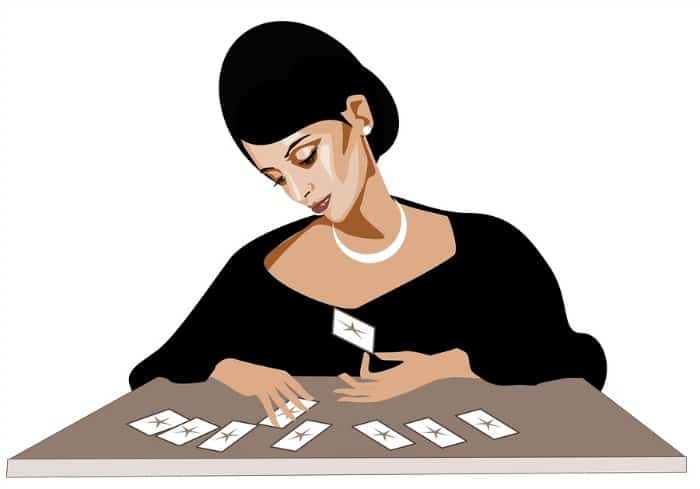Once you have an understanding of the potential meanings for the cards, it’s time to start reading tarot, my Tarotistas!
But first – a few wise words from Mama Theresa:
- Never approach tarot when you are overly emotional about a situation. Your feelings may cause you to color the interpretation for good or for ill.
- Center yourself before you begin to read. Simply closing your eyes and taking a few deep breaths may be enough to put yourself in the right state of mind.
- Tarot works best when you are not impaired. Refrain from substances before you work with the cards.
- Get clear on what you want to ask. The more specific the question, the more specific the answer.
- Tarot is not a substitute for medical, legal or psychiatric help. If you need any of the above, consult the proper professional.
- Don’t keep asking the same question over and over – beating a dead tarot horse only leads to frustration and mucked up answers.
- Always remember, if you do not like the outcome, you can change the situation. Ask strategic questions to look at other angles and escape chutes.
- Keep an open mind. Don’t worry about whether you are “right or wrong”. Just put your interpretation out there and then let things percolate. Sometimes the answer will be crystal clear. Other times, not so much. Often with time we understand the reading more.
- There are MANY ways to interpret a card. Don’t get hung up on “one true meaning”.
The format I use:
I’m all about having the right environment for reading. When you are reading tarot, be sure to have a quiet space. This will ensure you can concentrate, which makes for a better reading.
First, think of your question. Be sure to get as clear as you can. Decide which spread you are going to use (There are many to choose from – these are patterns for laying out the cards. A position in a spread can determine the meaning).
Begin shuffling the cards in a manner that is comfortable for you. Continue shuffling as you focus on your question. When you feel ready, put the deck face down on your table.
Cut the deck three times with your left hand (I always use the left hand because it’s the hand closest to your heart – the reading then comes from your heart. If you are compelled to use your right hand, that’s fine.). Then, put the deck back together any way that you wish.
Lay out the cards for your chosen spread.
Once you have focused on your question and laid out the cards in your chosen spread, it’s time to begin interpreting!
Here’s what to do:
- Scan the spread to see what the majority is (Majors, Minors, Courts, reversals, etc). Is there a consistent pattern? Make a note. Are the cards “lower numbers” (the beginning of a situation) or “higher numbers” (a situation coming to a conclusion)? Are the cards moving in sequence (1,2,3, etc) or all over the place (5, 2, 9, 3)?
- Start reading the cards one at a time, preferably in sequential order (if the spread has one).
- If you are stuck on a card, move on. Make a note of it and come back to it later. If you are not “feeling it”, let it go. Feel free to look up possible interpretations if you need to.
- Pay close attention to the card that “grabs you” the most.
- After a while, ditch the books and start reading from your gut.
A few notes:
- Practice often – on as many people as you can. The more diverse people/situations you can work with, the better you’ll get.
- You are human. You will make mistakes (even if you have been reading a long time!). Cut yourself some slack. Nobody is perfect.
- Look at the actions the figures are taking. Are they seated? Moving? That can be a clue.
- If you draw a blank, try describing the card and then develop an interpretation from that. This method often helps to get the tarot brain working.
- Learn a variety of simple spreads. You’ll want to have different spreads for different needs.
- Take classes from different teachers – you might learn a new perspective.
Learn more:
Good books on tarot spreads:
Tarot Spreads: Layouts & Techniques to Empower Your Readings by Barbara Moore
Classic Tarot Spreads by Sandor Konraad
Learning Tarot Spreads by Joan Bunning
Good books on tarot techniques:
Tarot Face to Face: Using the Cards in Your Everyday Life by Marcus Katz and Tali Goodwin
Best Tarot Practices: Everything You Need to Know to Learn the Tarot by Marcia Masino
Mary K. Greer’s 21 Ways to Read a Tarot Card by Mary Greeer
Rachel Pollack’s Tarot Wisdom: Spiritual Teachings and Deeper Meanings by Rachel Pollack
Tarot podcasts:
Beyond Worlds – Free tarot education with Donnaleigh de la Rose and her crew
Always remember – no matter how long you have read tarot, you can ALWAYS learn new things. Keep a beginner’s mind and keep on truckin’.
Blessings,
Theresa
image from stock photography


 I’m Theresa Reed (aka, The Tarot Lady). I’ve been a full-time tarot reader for 30+ years — which, in my industry, makes me pretty badass.
I’m definitely not your average Tarot expert — I drop the F-bomb, I quote rappers, and I’m obsessed with pop culture + reality TV. Folks come to me for straight-talk + tough-love — without the woo-woo fluff.
I’m Theresa Reed (aka, The Tarot Lady). I’ve been a full-time tarot reader for 30+ years — which, in my industry, makes me pretty badass.
I’m definitely not your average Tarot expert — I drop the F-bomb, I quote rappers, and I’m obsessed with pop culture + reality TV. Folks come to me for straight-talk + tough-love — without the woo-woo fluff.
You must be logged in to post a comment.